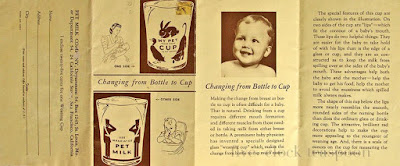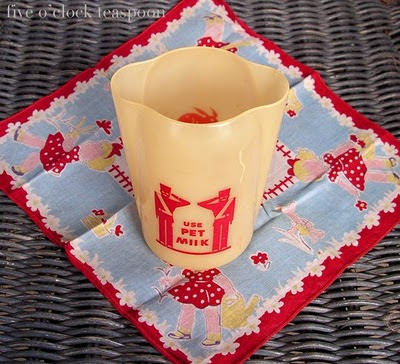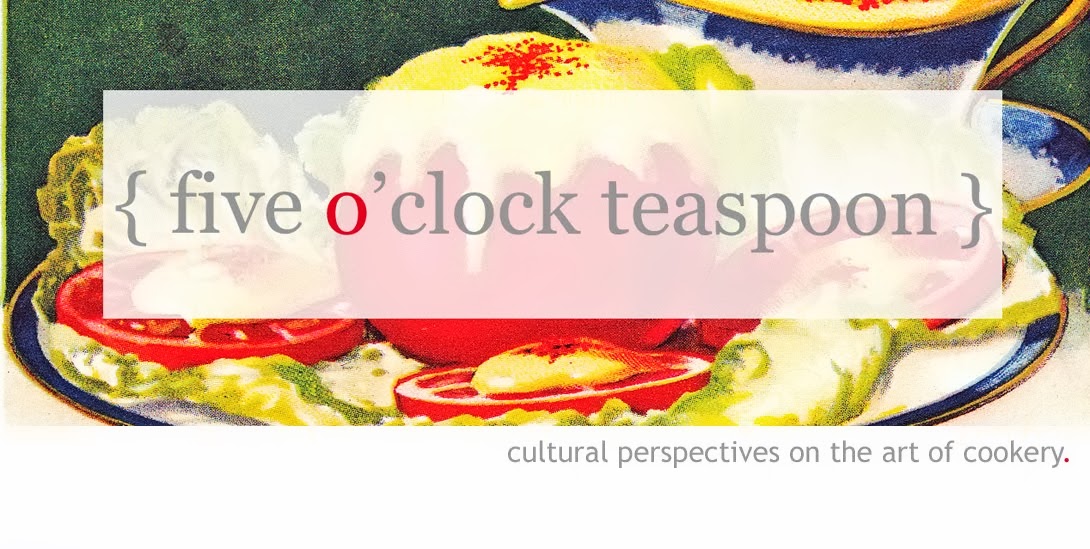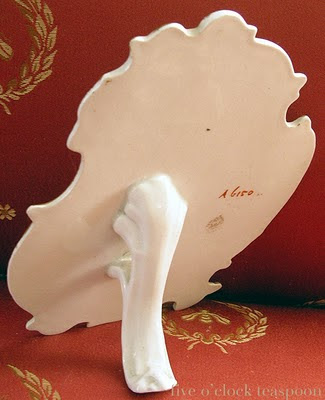
A child's first food is often a rite of passage, an induction into the pressures, constraints, hopes, and beliefs of the society in which she/he will be raised. Shoba Narayan begins her memoir,
Monsoon Diary, writing about the symbolic resonance of her first food-- rice with ghee fed by a Hindu priest at the Guruvayur temple in Kerala, as part of the traditional
choru-unnal, or rice eating, ceremony. Although a baby's first food may be culturally determined, the notion of baby food, as a distinct commercial object, is a 20th century invention. As sociologists and historians have shown, the creation of baby food is closely tied to an overall shift toward what culinary historian Ann Bentley terms, the "medicalization of childbirth and infancy" in America, particularly in the decades after World War II ("Inventing Baby Food: Gerber and the Discourse of Infancy in the United States," in
Food Nations).

Promotional Plastic Weaning Cup Produced for the PET Milk Co. Also found in glass form.
C
ommodifying MotherhoodWhile breast milk was once understood to be sufficiently nutritious for babies, by the 1950s it had become standard for mothers to feed their babies with formula (Rima Apple,
A Social History of Infant Feeding, 1890-1950). Advertising played a key role in convincing mothers that formula and mass-produced baby food were not only superior to breast milk and homemade baby food, but also necessary in a modern age that conflated food and scientific technology.
A look at a ca. 1950 pamphlet from the PET Milk Company (1885-present) advertising a weaning cup for their irradiated dry milk alternative to breast milk, illustrates some of these points.

Pamphlet Advertising "My PET Cup"
The pamphlet cover depicts a woman feeding a baby with a bottle in one frame, and in the next frame, the baby is shown sitting upright in a chair, successfully drinking, unaided, from a weaning cup. The sequence conveys the idea that the child in now independent of the mother and is not only feeding without her help, but sitting without her as well. Quite strikingly, the mother is completely removed from the situation, except as the implicit consumer to which the pamphlet is speaking. As Bentley points out in the case of Gerber baby food, advertisements often trumpeted the idea of freeing up a mother's time and hands.
The first segment of information that follows in the pamphlet characterizes weaning as a medical condition that requires a doctor's knowledge to treat:
Making the change from breast or bottle to cup is often difficult for a baby. That is natural. Drinking from a cup requires different mouth formation and different muscles from those needed in taking milk from either breast or bottle. A prominent baby physician has invented a specially designed glass "weaning cup" which makes the change from bottle to cup much easier.
The next segment describes the weaning cup's unique "lips" and extols the benefits of this design:
These advantages help both the baby and the mother-- help the baby to get his food, help the mother to avoid the mussiness which spilled milk always makes.Anonymous health professionals are quoted as experts in child development, suggesting a transference of authority from the mother to the medical establishment:
Many of these cups have been used by mothers, under the observation of physicians, and they have proved most helpful in training the baby to take his food in the new way. The more easily the baby can take his food from the cup, the more readily he will learn to do it. A further advantage is that the child will learn more quickly to take his milk from the cup without assistance, and helping himself, psychologists agree, is an important principle in sound training.
By emphasizing the importance of a baby's independence and a reliance on medical advice, the passage prescribes the correct behavior for the baby, who learns to "help himself" and the mother, who understands that medical opinion is essential to how she raises her child.

{Click to enlarge}
The last few segments reflect the period's concerns over food safety. The pamphlet stresses the nutritional value of PET irradiated milk, which featured vitamin D to prevent rickets, and emphasizes the safety of the product, reassuring mothers that PET Milk is sterile, digestible, and nutritious, as well as convenient and economical.
By invoking the approval of doctors, such advertising attempts to correlate commercially produced baby food with a trusted source, thereby validating the product in the minds of consumers.

{Click to enlarge}
Like many companies, PET Milk strengthened its presence through associated merchandise such as the weaning cup. I recently found a promotional booklet from around the same period produced by the same company, featuring recipes for a variety of popular mid-20th century dishes made with PET dry milk powder.
I made the Brownies using dry milk and was pleasantly surprised at how good they were-- chewy, light, and even better the next day. Any brand of dry milk will do and I replaced the shortening with butter. The original recipe is reproduced below:
 Brownies
Brownies, from
PET Nonfat Dry Milk Recipes by Mary Lee Taylor
Ingredients3/4 cup sifted, all-purpose flour
1 1/4 cups sugar
1/2 tsp baking powder
1/4 tsp salt
1/2 cup cocoa
1/3 cup PET Nonfat Dry Milk
1/2 cup soft shortening
2 unbeaten eggs
2 Tbs water
1 tsp vanilla
1/2 cup broken, unsalted nuts
Directions1. Turn on oven and set at 350 (moderate).
2. Grease well a pan measuring about 8x12 inches.
3. Sift together in a 2-quart bowl:
(the first 6 ingredients)4. Add all at once:
(the next 4 ingredients)5. Mix until well blended, then beat hard 1 minute.
6. Stir in:
(nuts)7. Spread batter in greased pan. Bake on center rack of oven 25 minutes, or until cake pulls from sides of pan. Cool in pan about 30 minutes. Cut into 16 squares.
Note: If you would like thicker brownies, use a 9-inch square pan and increase baking time to 30 minutes. Cut into 16 squares.
For Brownies a la Mode, a delicious company dessert, put a scoop of vanilla ice cream on each brownie, then sprinkle grated chocolate or chopped nuts over ice cream.


See also:
Selling Milk Between the Wars: Two Pre-WWII U.S. Milk Industry Booklets, Part IFurther ReadingApple, Rima.
A Social History of Infant Feeding, 1890-1950. Madison: University of Wisconsin Press, 1987.
Bentley, Ann. "Inventing Baby Food: Gerber and the Discourse of Infancy in the United States." In Belasco, Warren and Philip Scranton, eds.
Food Nations: Selling Taste in Consumer Societies. New York: Routledge, 2002.
Dunn, Elizabeth.
Privatizing Poland: Baby Food, Big Business, and the Remaking of Labor. Ithaca: Cornell University Press, 2004.















































